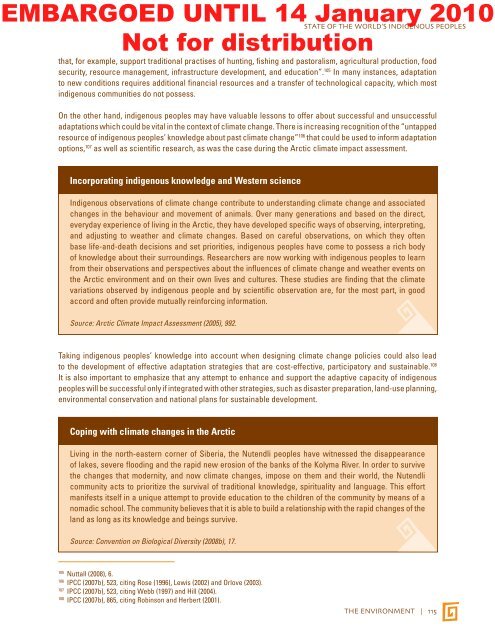STATE OF THE WORLD's INDIGENOUs PEOpLEs - CINU
STATE OF THE WORLD's INDIGENOUs PEOpLEs - CINU
STATE OF THE WORLD's INDIGENOUs PEOpLEs - CINU
- No tags were found...
Create successful ePaper yourself
Turn your PDF publications into a flip-book with our unique Google optimized e-Paper software.
EMBARGOED UNTIL 14 January 2010<strong>STATE</strong> <strong>OF</strong> <strong>THE</strong> WORLD’S INDIGENOUS PEOPLESNot for distributionthat, for example, support traditional practises of hunting, fishing and pastoralism, agricultural production, foodsecurity, resource management, infrastructure development, and education”. 105 In many instances, adaptationto new conditions requires additional financial resources and a transfer of technological capacity, which mostindigenous communities do not possess.On the other hand, indigenous peoples may have valuable lessons to offer about successful and unsuccessfuladaptations which could be vital in the context of climate change. There is increasing recognition of the “untappedresource of indigenous peoples’ knowledge about past climate change” 106 that could be used to inform adaptationoptions, 107 as well as scientific research, as was the case during the Arctic climate impact assessment.Incorporating indigenous knowledge and Western scienceIndigenous observations of climate change contribute to understanding climate change and associatedchanges in the behaviour and movement of animals. Over many generations and based on the direct,everyday experience of living in the Arctic, they have developed specific ways of observing, interpreting,and adjusting to weather and climate changes. Based on careful observations, on which they oftenbase life-and-death decisions and set priorities, indigenous peoples have come to possess a rich bodyof knowledge about their surroundings. Researchers are now working with indigenous peoples to learnfrom their observations and perspectives about the influences of climate change and weather events onthe Arctic environment and on their own lives and cultures. These studies are finding that the climatevariations observed by indigenous people and by scientific observation are, for the most part, in goodaccord and often provide mutually reinforcing information.Source: Arctic Climate Impact Assessment (2005), 992.Taking indigenous peoples’ knowledge into account when designing climate change policies could also leadto the development of effective adaptation strategies that are cost-effective, participatory and sustainable. 108It is also important to emphasize that any attempt to enhance and support the adaptive capacity of indigenouspeoples will be successful only if integrated with other strategies, such as disaster preparation, land-use planning,environmental conservation and national plans for sustainable development.Coping with climate changes in the ArcticLiving in the north-eastern corner of Siberia, the Nutendli peoples have witnessed the disappearanceof lakes, severe flooding and the rapid new erosion of the banks of the Kolyma River. In order to survivethe changes that modernity, and now climate changes, impose on them and their world, the Nutendlicommunity acts to prioritize the survival of traditional knowledge, spirituality and language. This effortmanifests itself in a unique attempt to provide education to the children of the community by means of anomadic school. The community believes that it is able to build a relationship with the rapid changes of theland as long as its knowledge and beings survive.Source: Convention on Biological Diversity (2008b), 17.105Nuttall (2008), 6.106IPCC (2007b), 523, citing Rose (1996), Lewis (2002) and Orlove (2003).107IPCC (2007b), 523, citing Webb (1997) and Hill (2004).108IPCC (2007b), 865, citing Robinson and Herbert (2001).<strong>THE</strong> ENVIRONMENT | 115
















